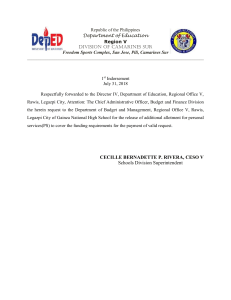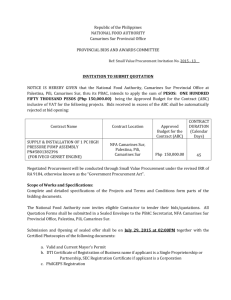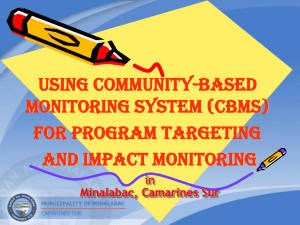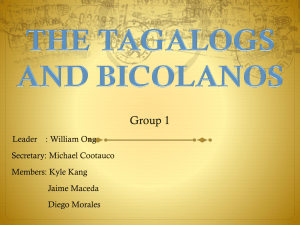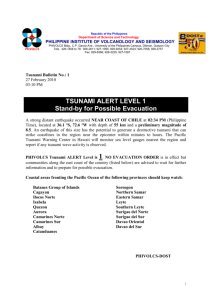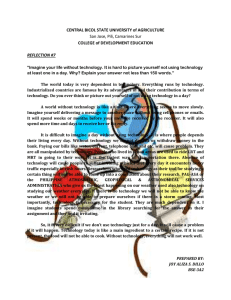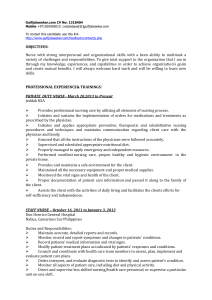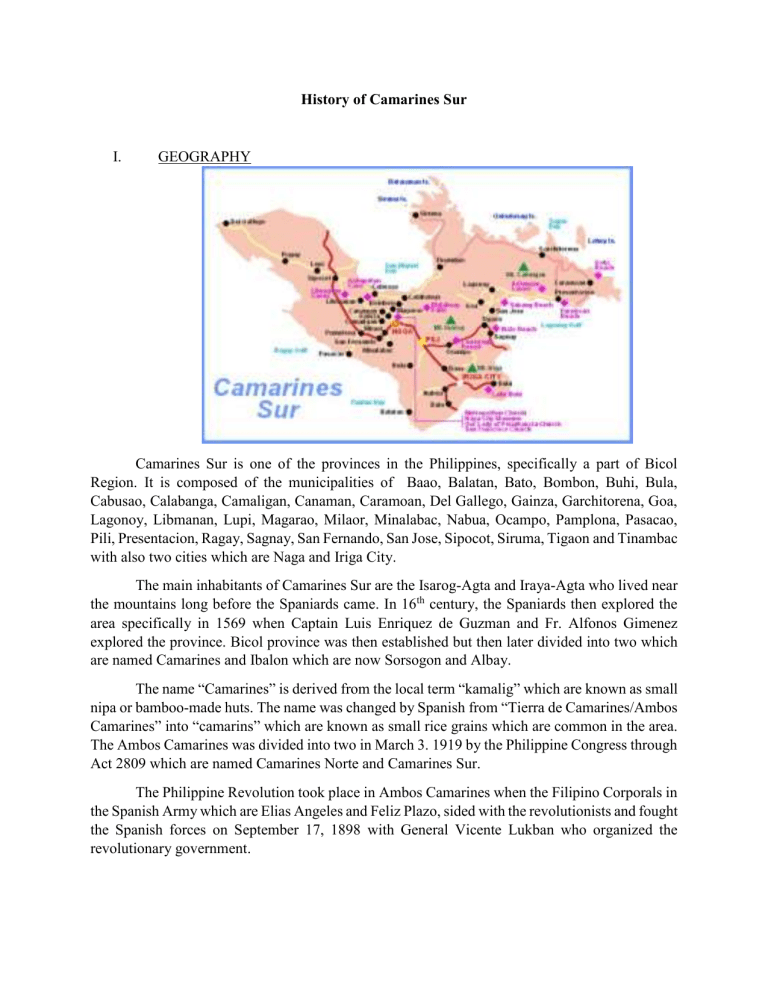
History of Camarines Sur I. GEOGRAPHY Camarines Sur is one of the provinces in the Philippines, specifically a part of Bicol Region. It is composed of the municipalities of Baao, Balatan, Bato, Bombon, Buhi, Bula, Cabusao, Calabanga, Camaligan, Canaman, Caramoan, Del Gallego, Gainza, Garchitorena, Goa, Lagonoy, Libmanan, Lupi, Magarao, Milaor, Minalabac, Nabua, Ocampo, Pamplona, Pasacao, Pili, Presentacion, Ragay, Sagnay, San Fernando, San Jose, Sipocot, Siruma, Tigaon and Tinambac with also two cities which are Naga and Iriga City. The main inhabitants of Camarines Sur are the Isarog-Agta and Iraya-Agta who lived near the mountains long before the Spaniards came. In 16th century, the Spaniards then explored the area specifically in 1569 when Captain Luis Enriquez de Guzman and Fr. Alfonos Gimenez explored the province. Bicol province was then established but then later divided into two which are named Camarines and Ibalon which are now Sorsogon and Albay. The name “Camarines” is derived from the local term “kamalig” which are known as small nipa or bamboo-made huts. The name was changed by Spanish from “Tierra de Camarines/Ambos Camarines” into “camarins” which are known as small rice grains which are common in the area. The Ambos Camarines was divided into two in March 3. 1919 by the Philippine Congress through Act 2809 which are named Camarines Norte and Camarines Sur. The Philippine Revolution took place in Ambos Camarines when the Filipino Corporals in the Spanish Army which are Elias Angeles and Feliz Plazo, sided with the revolutionists and fought the Spanish forces on September 17, 1898 with General Vicente Lukban who organized the revolutionary government. Americans occupied Camarines Sur from 1900 to 1942 and then the Japanese invaded the province after the Americans has left the area. During World War II, Guerilla units waged underground operations against the Japanese troops stationed in Camarines Sur. These were organized by Wenceslao Q. Vinzons who was then captured on July 8, 1942. He was then replaced by Lieutenant Francisco Boayes until April 1945 when Camarines Sur was free from the Japanese invaders towards the end of World War II. Naga City, formerly known as “Nueva Caceres” was designated as the Capital of Province by the Philippine Legislative Act No. 2711 on March 10,1917 but later changed when Pili was declared as the Provincial Capital on June 6, 1955 by the Republic Act 1336 up to the present time. II. LIVELIHOOD Agriculture is the main source of livelihood in the Province. Rice, corn, coconut, sugar and abaca are the raw products collected in the province. Handicrafts such as bags, hats and slippers are made from the abaca which are source of livelihood. Fishing is also one of the major sources of livelihood since the province is a coastal area. III. LANGUAGES There are several dialects used in the province, but the main language used is the Coastal Bikol. It is composed of several dialects such as the Coastal Bikol-Partido which is used in the eastern part of the province. Coastal Bikol-Central is spoken in Naga City. Rinconada Bikol is used by the people staying in the Rinconada area especially in Nabua and Iriga City. Buhinon is also used by people in Buhi. Only one town speaks Tagalog which is Del Gallego. Tagalog and English are also used and widely understood by the inhabitants of Camarines Sur. According to the Jesuit anthropologist Frank Lynch S.J., the Coastal Bikol dialect used in Canaman is the purest form of Bikol. IV. TRADITIONS AND BELIEFS Since Camarines Sur was invaded by Spaniards, their beliefs were preserved by the Bicolanos. The invisible world is acknowledged by the common expression “Tabi po, maki-agi po” which means “Excuse me please, I would like to pass by” for people not to accidentally bump into creatures that are not seen by bare eyes. There are also indigenous beliefs that are practiced until now. In San Miguel Bay, people are not allowed to point at anything when riding a boat since the spirits may get mad and drown the boat including the passengers. In Naga City, if a child goes near the riverside, the spirits may push him to drown him in the water. V. RELIGION Camarines Sur is known for being a religious province dominant with Catholicism. The patron saint of Bicol is Our Lady of Peñafrancia. Every September, thousands of barefooted male devotees join the Traslacion procession of the patron saint and a fluvial procession wherein the image of the patron saint is carried on the “Pagoda” or the boat loaded by male priests and devotees. The Pagoda is then pulled by numbers of boats until it reaches the area near the Basilica Church. Sources: https://dollyoliver.wordpress.com/collection-of-poems/ https://pia.gov.ph/provinces/camarines-sur https://www.psacamsur.com/the-province/history/
